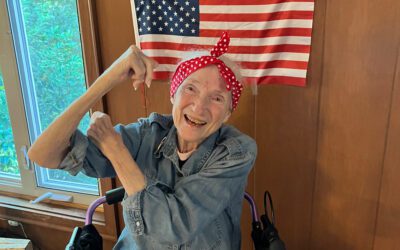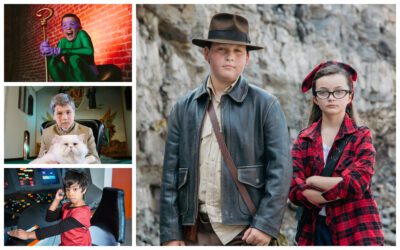If it weren’t for physical resemblance and an encyclopedic knowledge of his subject, there’s nothing in mild-mannered Floyd Robison that would suggest anything in common with a figure as notorious as frontier judge and Fort Smith legend Isaac Parker. But look a little closer and certain similarities begin to emerge.
Both men came of age in times of war. Parker was twenty-three when the Civil War broke out, enlisting in the 61st Missouri Emergency Regiment. Floyd served one term in Vietnam in a helicopter task squadron during three years in the U.S. Navy after high school. And both men are arguably better known by their nicknames: “Sonny” for Floyd; for Parker, the Hanging Judge.
Throw in Sonny’s wife, Sue, and the coincidental similarities go from interesting to downright eerie.
“[Parker’s wife] Mary was a Catholic who married a Methodist boy; Sue was Catholic and I grew up Methodist,” Sonny shares with glee. “I have blue eyes and Parker had blue eyes. Sue’s Irish, Mary was Irish.”
Perhaps it’s because of these similarities that Sonny has been so committed to telling the true story of the legendary frontier barrister. For twenty years, he’s assumed the persona of the judge in reenactments and various appearances, infusing the kind of humanity into his portrayal that so often fails to make the history books.
In his recurring role as Fort Smith Judge Isaac Parker, Floyd “Sonny” Robison portrays a figure who looms larger than life. In a lesser-known aspect of his service to the community’s historical organizations, the Vietnam vet takes it in the other direction.
A natural craftsman, Sonny has fashioned historically accurate replicas to portray life on the frontier and in the early days of the city when Fort Smith stood as a gateway to the wild, wild West.
“It’s just kind of progressed from one thing to the next,” he says.
Sonny got started in his hobby as a way to support Clarion House where his wife, Sue, regularly gave presentations. “As a fundraiser, she wanted to do these doll houses to give to kids or auction them off as fundraisers,” he said. “Well, I started buying these doll house kits and then I would add to the house, add furniture and even make furniture for it.”
Sonny once set up his work area in the dining room of the couple’s home and as he worked, his ambition got the better of him. “It was a Barbie-sized scale, two stories and an attic,” he said. “It was five feet long and about two or three feet wide. We had to load it in a van to deliver it.”
“Yes, and it destroyed our floor,” Sue notes. “So, I got a new floor, and he got a new workshop.”
In the new space Sonny’s woodworking hit high gear. He continued to build dollhouses then branched out into other projects.
“I built a log cabin out of dowel rods,” he said. “We progressed from there and I got more tools and better tools. That’s when we started doing things for the Fort Smith Museum of History.”
Sonny’s handiwork includes a covered wagon complete with hand-carved and painted oxen and individual goods that homesteaders would have toted on their way West. He’s also built a boat in miniature, complete with handmade miniature figurines of captain and crew.
“We put together a stagecoach,” Sonny says. “The Fairfield Trail went through here and the Butterfield Stagecoach would come through and then continue out west. The museum wanted to do a little storybook about the stagecoach and transportation as a summer reading thing. So, I bought a little stagecoach kit, put it together and I had to get six horses because it didn’t have any horses in the kit. We bought horses online, I painted them and got that done.”
Sonny’s versatility has seen him pressed into service for several historical projects.
“We have walking tours on Garrison Avenue, where characters come out portraying different people,” he said. “Two were Bonnie and Clyde. We didn’t have a machine gun, so I made them a submachine gun out of wood. It had the round disc for the cylinder. I also made a pistol and a sawed-off shotgun out of wood.”
As time went along, the requests got even more ambitious. After he completed the miniature keelboat, Leisa Gramlich, the museum’s executive director, asked if he could create something larger for the kids.
“I made a skiff, a flat-bottom boat that ran up the river around 1817. They explored the Arkansas River with them,” he says. “I built it with a friend of mine, and it was not necessarily to scale, but I made oars with oar locks and the kids could pretend to row the boat. It had a sail that went up and down. And I made a flag for it.”
From there, he and a companion equipped the museum’s replica Victorian school room where a volunteer reenactor shows schoolchildren how education was delivered in frontier days. “Me and another guy built a bookcase and other items for the schoolhouse,” Sonny says. “They had writing slates back then, so I made six of them.”
Once word got out about Sonny’s handiwork, it didn’t take long for other historical entities in town to raise their hands for other projects. One of the most ambitious dovetailed into his longtime portrayal of Judge Isaac Parker.
“I built a courtroom set, including a desk, a chair, tables and bookcase so we could have a setting for our presentations,” he says. “I also built a gallows, a replica of the Judge Parker gallows. And it works. Had a trap door and we put sandbags on it. People really seem to like that.”
Visitors to the nearby Trolley Museum can also see samples of Sonny’s woodworking skill. “They put together a village scene with houses, a Victorian neighborhood,” he says. “I made a 1/12th-scale replica of the trolley with the wiring up above it and the track on a little display. We donated it to the Trolley Museum.”
Asked what keeps him so involved, Sonny says he enjoys the process of educating the community about its history, especially youth. It’s an attitude he shares with Sue.
“For me it’s teaching young people and others the facts of things and telling them the truth about stuff instead of what Hollywood tells you,” Sonny notes.
“I really like the idea of getting people involved in history,” Sue says. “We used to tell people that we weren’t going to lie to them because we didn’t have to. Fort Smith has such an amazing history all our stories are true, and they are fascinating enough.”
These days, the Robisons have eased up on their reenactments a little, but still make the rounds to classrooms during the school year to give students a living look at the history of their hometown. And the projects keep coming.
“I’m working on a military bus for Fort Chaffee at Chaffee Crossing,” Sonny says. “We’ve built quite a bit. I always have something I’m working on.”
And so, it seems Sonny has found yet another incredible way to leave his mark on history. His community service yet another thing he holds in common with the misunderstood Judge Parker.
“Here’s a story,” he says. “They called him the Hanging Judge, but the kids called him something else. The Parkers lived on North 13th, and he would walk down the avenue on his way to work. First National Bank was there at the time, and it had a little candy shop and ice cream store in it. He would stop and get his ice cream and he’d buy candy and put it in his pockets. He went back out and when the kids came around, he handed them candy. So, the kids called him the Candy Man.”
Learn more about Judge Isaac Parker and view Sonny’s handiwork by visiting these historical sites:
Fort Smith Museum of History
320 Rogers Avenue, Fort Smith, Arkansas
479.783-7841 / fortsmithmuseum.org
Fort Smith National Historic Site
301 Parker Avenue, Fort Smith, Arkansas
479.783.3961 / nps.gov




